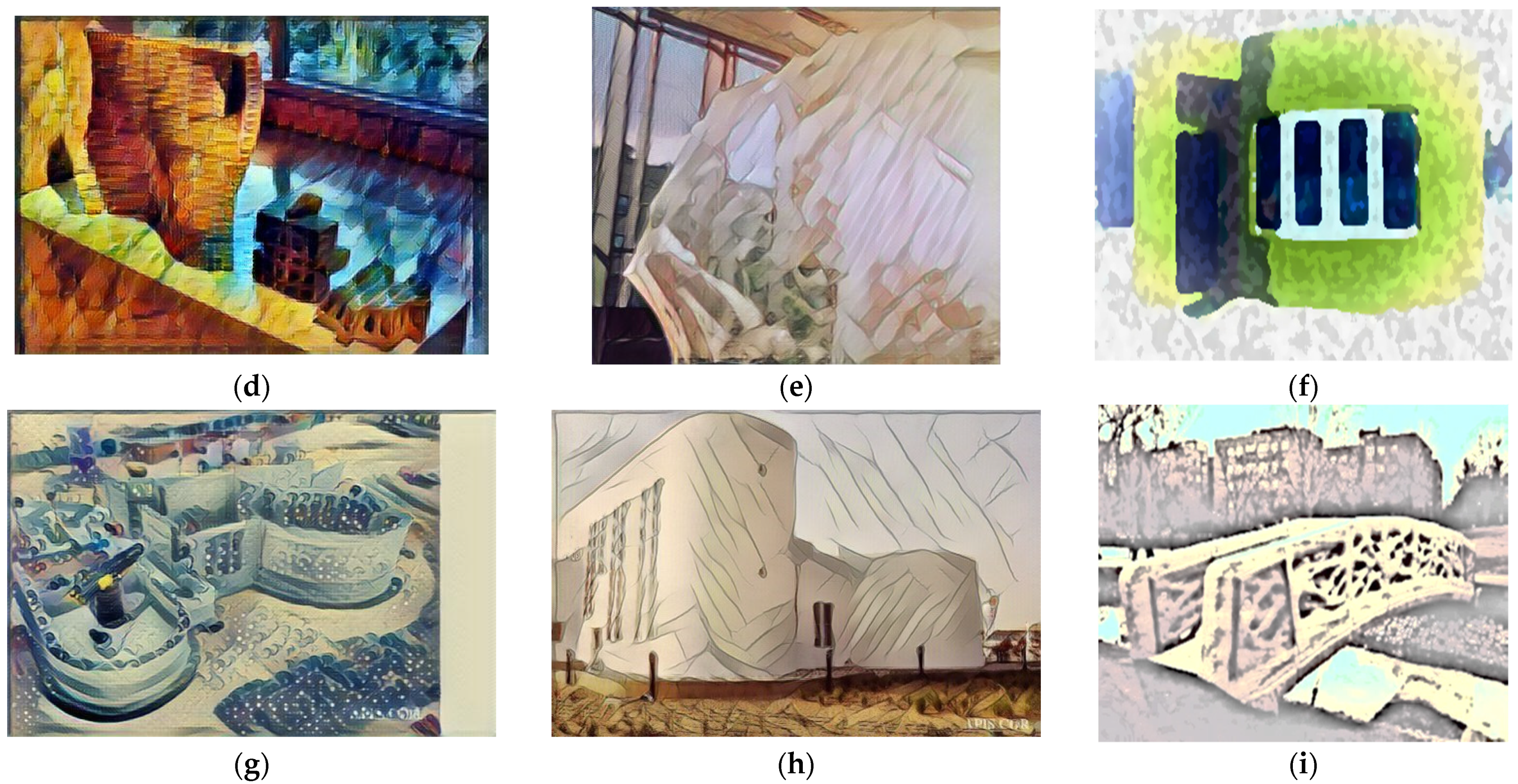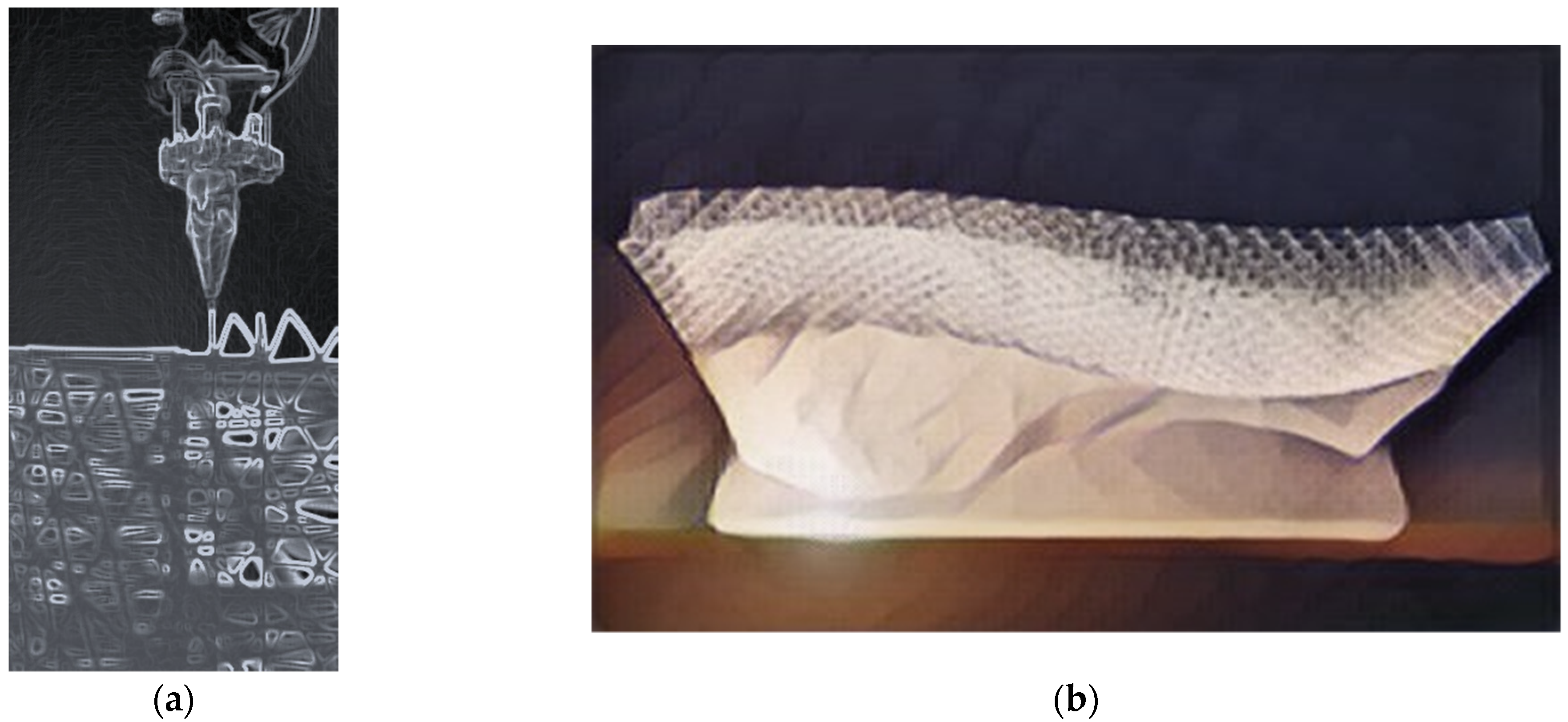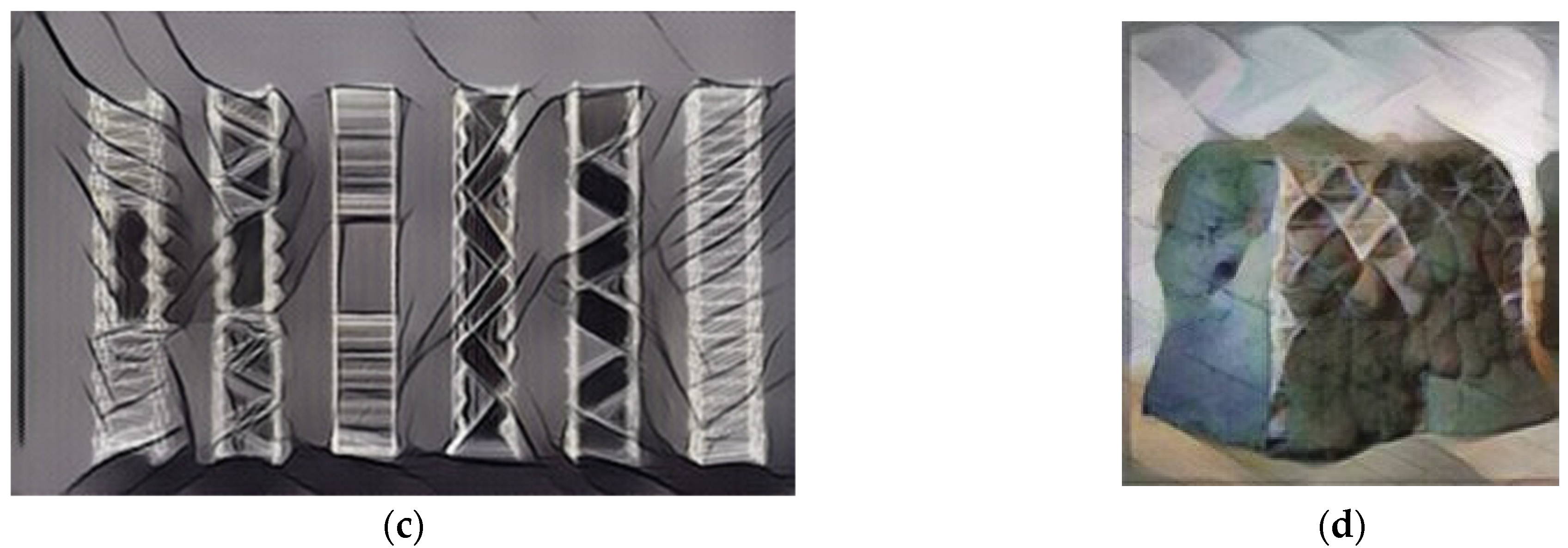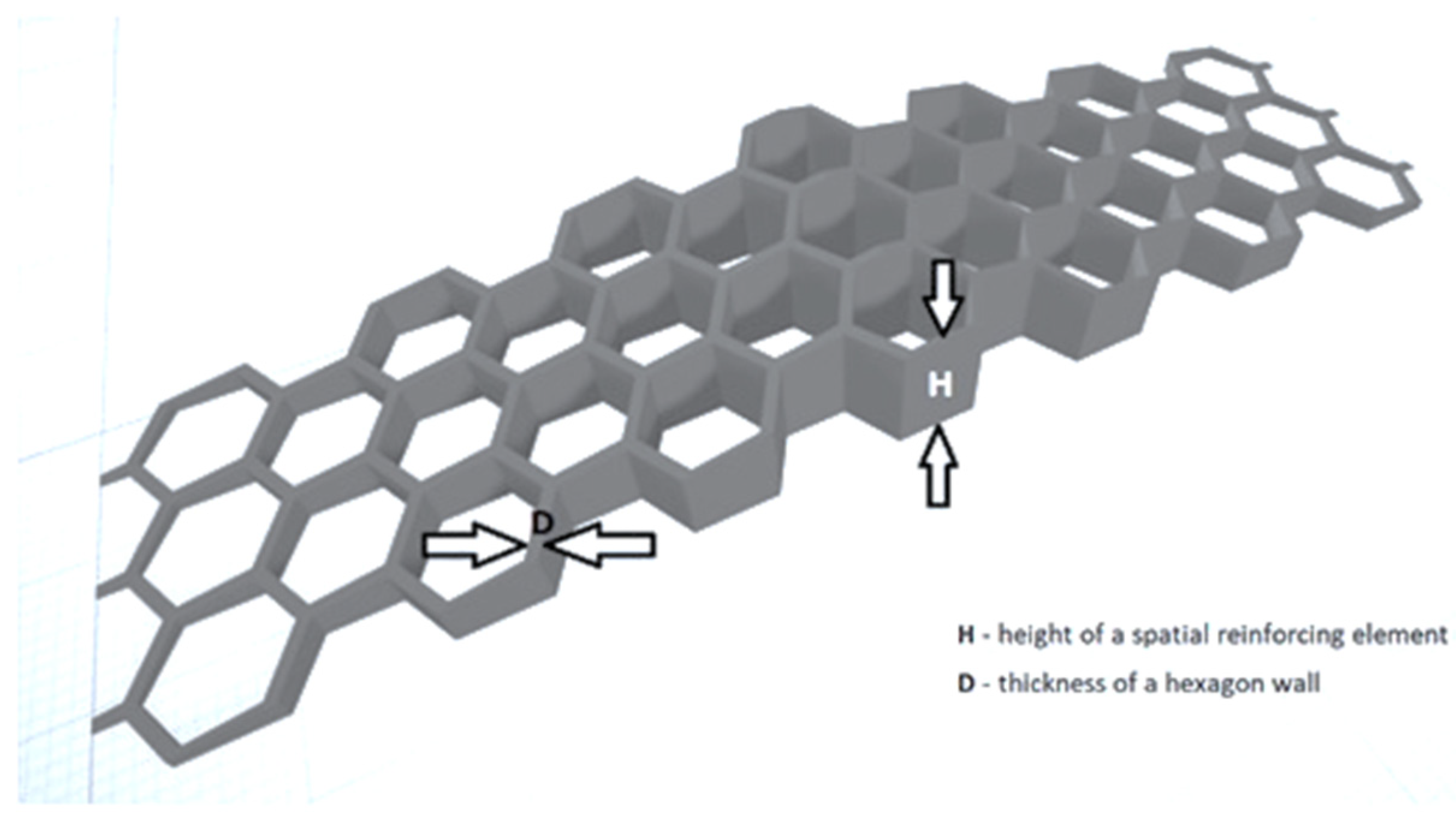Harnessing 3D Printing of Plastics in Construction—Opportunities and Limitations
Abstract
:1. Introduction
2. 3D Printing of Concrete and Metals
3. 3D Printing of Plastics for Construction
4. Opportunities and Challenges
5. Conclusions
Author Contributions
Funding
Institutional Review Board Statement
Informed Consent Statement
Data Availability Statement
Conflicts of Interest
Appendix A
| Bibliography Item | Property | Value | Unit |
|---|---|---|---|
| [53] | Compressive strength mortar | 22.7 | MPa |
| Flexural strength mortar | 4.3 | MPa | |
| Splitting tensile strength mortar | 2.8 | MPa | |
| Apparent density mortar | 2040 | kg/m3 | |
| Dynamic modulus of elasticity mortar | 32.0 | GPa | |
| Column strain (depening on the cross-section) | 1.7–3.5 | % | |
| Compressive strength columns—full area of a cross-section (depening on the cross-section) | 16.5–24.7 | MPa | |
| Compressive strength columns—only area of concrete (depening on the cross-section) | 20.9–28.4 | MPa | |
| The energy needed to obtain the deformation at the achievement of the maximum force of columns (depening on the cross-section) | 18.3–51.0 | J | |
| [54] | Compressive strength cement matrix | 45.6 | MPa |
| Flexural strength matrix | 7.0 | MPa | |
| Flexural strength of formwork—matrix element with no ribs | 12.8 | MPa | |
| Flexural strength of formwork—matrix element with 3 ribs of 15 mm | 30.4 | MPa | |
| [55] | Compressive strength mortar | 43.3 | MPa |
| Flexural strength mortar | 8.0 | MPa | |
| The amount of energy needed to obtain the maximum bending force | from 244 (for H = 5 mm and d = 1.00 mm) to 7049 (for H = 20 mm and d= 2.00 mm) | Nmm | |
| Flexural toughness of tested prism specimens dor l/150 | 700–1300 | Nmm | |
| Flexural toughness of tested prism specimens dor l/75 | 2500–4500 | Nmm | |
| [57] | The flexural strength of plain mortar | 5.8 | MPa |
| The flexural strength for reinforced samples | <5.8 | MPa | |
| Obtained deflection for the plain mortar | <0.1 | mm | |
| Obtained deflection for the reinforced samples | 0.6–1.0 | mm | |
| Ductile failure strength | 0.0—for the plain mortar; 2.74–3.69 for the reinforced samples | MPa | |
| Normalized ductile failure strength | 0.0—for the plain mortar; 3.31–5.56 for the reinforced samples | MPa | |
| Total work | 0.07—for the plain mortar; 0.59–0.91 for the reinforced samples | J | |
| Normalized total work | 0.07—for the plain mortar; 30.34–45.52 for the reinforced samples | J/cm3 | |
| [58] | Peak load | 0.77 (randomness 0.1); 0.66 (randomness 0.5) | kN |
| Slope | 2.06 (randomness 0.1); 1.57 (randomness 0.5) | kN/mm | |
| [60,61,62] | Flexural strength | 4.58 (reference sample); 4.69–6.30 (reinforced samples) | MPa |
| Deflection capacity | 0.36 (reference sample); 0.34–5.55 (reinforced samples) | mm | |
| Tensile strength | 3.14 (reference sample); 2.42 (reinforced sample ST) | MPa | |
| Strain capacity | 0.02 (reference sample); 0.58 (reinforced sample ST) | % | |
| [63] | Flexural strength of reinforced samples (depends on the type of reinforcement) | 2.30–3.04 | MPa |
| Deflection capacities (depends on the type of reinforcement) | 0.05–0.58 | mm | |
| Peak toughness (depends on the type of reinforcement) | 15.92–652.37 | Nmm | |
| [64] | Deflection | <0.5 (reference sample); 2.5–4.00 (reinforced sample) | mm |
| Maximum load | 0.6 (reference samples); 0.45–0.55 (with polymeric fibers); 1.1–1.6 (with metallic fibers) | kN | |
| Thougness index | 2.87–3.12 (with polymeric fibers); 41.63–51.15 (with metallic fibers) | - | |
| [65] | First crack load | 2056 for beams with PLA; 1553 for beams with PETG | N |
| Max load | 3296 for beams with PLA; 6321 for beams with PETG | N | |
| Max strength | 5.9 for beams with PLA; 11.4 for beams with PETG | MPa | |
| Energy | 16.3 for beams with PLA; 91.6 for beams with PETG | J |
References
- Bose, S.; Vahabzadeh, S.; Bandyopadhyay, A. Bone tissue engineering using 3D printing. Mater. Today 2013, 16, 496–504. [Google Scholar] [CrossRef]
- McCullough, E.J.; Yadavalli, V.K. Surface modification of fused deposition modeling ABS to enable rapid prototyping of biomedical microdevices. J. Mater. Process. Technol. 2013, 213, 947–954. [Google Scholar] [CrossRef]
- Kothman, I.; Faber, N. How 3D printing technology changes the rules of the game Insights from the construction sector. J. Manuf. Technol. Manag. 2016, 27, 932–943. [Google Scholar] [CrossRef]
- Huang, S.H.; Liu, P.; Mokasdar, A.; Hou, L. Additive manufacturing and its societal impact: A literature review. Int. J. Adv. Manuf. Technol. 2013, 67, 1191–1203. [Google Scholar] [CrossRef]
- Tay, Y.W.D.; Panda, B.; Paul, S.C.; Noor Mohamed, N.A.; Tan, M.J.; Leong, K.F. 3D printing trends in building and construction industry: A review. Virtual Phys. Prototyp. 2017, 12, 261–276. [Google Scholar] [CrossRef]
- Gibson, I.; Rosen, D.W.; Stucker, B. Additive Manufacturing Technologies: Rapid Prototyping to Direct Digital Manufacturing; Springer: New York, NY, USA, 2010. [Google Scholar] [CrossRef]
- Ghaffar, S.H.; Corker, J.; Fan, M. Additive manufacturing technology and its implementation in construction as an eco-innovative solution. Autom. Constr. 2018, 93, 1–11. [Google Scholar] [CrossRef]
- Gebler, M.; Schoot Uiterkamp AJ, M.; Visser, C. A global sustainability perspective on 3D printing technologies. Energy Policy 2014, 74, 158–167. [Google Scholar] [CrossRef]
- Gebhard, L.; Mata-Falcón, J.; Anton, A.; Dillenburger, B.; Kaufmann, W. Structural behaviour of 3D printed concrete beams with various reinforcement strategies. Eng. Struct. 2021, 240, 112380. [Google Scholar] [CrossRef]
- Hager, I. Rewolucja technologiczna w budownictwie—Druk 3D budynków i obiektów inżynieryjnych. In Ujęcie Aktualnych Problemów Budownictwa; Wydawnictwo Politechniki Śląskiej: Gliwice, Poland, 2018. [Google Scholar]
- Hager, I.; Golonka, A.; Putanowicz, R. 3D Printing of Buildings and Building Components as the Future of Sustainable Construction? Procedia Eng. 2016, 151, 292–299. [Google Scholar] [CrossRef] [Green Version]
- Ngo, T.D.; Kashani, A.; Imbalzano, G.; Nguyen, K.T.; Hui, D. Additive manufacturing (3D printing): A review of materials, methods, applications and challenges. Compos. Part B Eng. 2018, 143, 172–196. [Google Scholar] [CrossRef]
- Kreiger, M.A.; Mulder, M.L.; Glover, A.G.; Pearce, J.M. Life cycle analysis of distributed recycling of post-consumer high density polyethylene for 3-D printing filament. J. Clean. Prod. 2014, 70, 90–96. [Google Scholar] [CrossRef] [Green Version]
- Ma, G.; Li, Z.; Wang, L. Printable properties of cementitious material containing copper tailings for extrusion based 3D printing. Constr. Build. Mater. 2018, 162, 613–627. [Google Scholar] [CrossRef]
- Choi, J.W.; Medina, F.; Kim, C.; Espalin, D.; Rodriguez, D.; Stucker, B.; Wicker, R. Development of a mobile fused deposition modeling system with enhanced manufacturing flexibility. J. Mater. Process. Technol. 2011, 211, 424–432. [Google Scholar] [CrossRef]
- Berman, B. 3-D printing: The new industrial revolution. Bus. Horizons 2012, 55, 155–162. [Google Scholar] [CrossRef]
- Kruth, J.-P.; Leu, M.; Nakagawa, T. Progress in Additive Manufacturing and Rapid Prototyping. CIRP Ann. 1998, 47, 525–540. [Google Scholar] [CrossRef]
- Wong, K.V.; Hernandez, A. A Review of Additive Manufacturing. ISRN Mech. Eng. 2012, 2012, 208760. [Google Scholar] [CrossRef] [Green Version]
- Kret, W.; Michnowicz, M. Drukarka 3D oparta na dokumentacji. Eduk. Tech. Inform. 2013, 4, 393–397. [Google Scholar]
- Mehar, P.; Khobragade, P.; Mendhe, M.; Bhada, S.; Singh, V.; Salodkar, P. 3d Printing Trends in Building and Construction Industry. Int. J. Sci. Res. Sci. Technol. 2020, 7, 314–318. [Google Scholar] [CrossRef]
- Labonnote, N.; Rønnquist, A.; Manum, B.; Rüther, P. Additive construction: State-of-the-art, challenges and opportunities. Autom. Constr. 2016, 72, 347–366. [Google Scholar] [CrossRef]
- Major, M.; Minda, I. The use of 3D printing technologies in the civil engineering. Zesz. Naukowe Politech. Częst. Ser. Bud. 2016, 22, 238–247. [Google Scholar] [CrossRef]
- Javelin—A TriMech Company. Available online: https://www.javelin-tech.com/3d/industry/architecture/ (accessed on 6 May 2021).
- The World’s First Office from a 3D Printer. Ringier Axel Springer Polska Sp. z o.o. Członek Izby Wydawców Prasy i Związku Kontroli Dystrybucji Prasy. Available online: https://www.forbes.pl/life/wydarzenia/biuro-wydrukowane-drukarka-3d/jk9elx7 (accessed on 6 May 2021).
- Dodziuk, H. Druk 3D w budownictwie. Napędy Sterow. 2020, 12, 41–47. [Google Scholar]
- 10 Completely 3D Printed Houses Appear in Shanghai, Built under a Day. Available online: http://www.3ders.org/articles/20140401-10-completely-3d-printed-houses-appears-in-shanghai-built-in-a-day.html (accessed on 6 May 2021).
- Wheeler, A. Available online: http://3dprintingindustry.com/2015/01/19/winsun-3d-printing-building/ (accessed on 6 May 2021).
- Wang, L. Available online: https://inhabitat.com/chinese-company-builds-3d-printed-villa-inless-than-3-hours/ (accessed on 6 May 2021).
- Mendoza, H.R. 2016. Available online: https://3dprint.com/138336/syska-hennessy-dubai-office/ (accessed on 6 May 2021).
- Scott, C. 2018. Available online: https://3dprint.com/220965/sand-3d-printing-smart-slab/ (accessed on 6 May 2021).
- Rębosz-Kurdek, A.; Gierulski, W.; Szmidt, A. The innovative 3D printer head. Part 1. Concept. Mechanik 2018, 91, 538–542. [Google Scholar] [CrossRef]
- Drury, C. 2018. Available online: https://www.independent.co.uk/news/world/europe/3d-printed-home-world-first-france-a8298446.html (accessed on 7 May 2021).
- Boffey, D. 2018. Available online: https://www.theguardian.com/artanddesign/2018/jun/06/netherlands-to-build-worlds-first-habitable-3d-printed-houses (accessed on 7 May 2021).
- Cheniuntai, N. 2019. Available online: https://www.apis-cor.com/dubai-project (accessed on 7 May 2021).
- Gadomska, H. Największy na Świecie Budynek z Drukarki 3D Stanął Właśnie w Dubaju. 2020. Available online: https://www.focus.pl/artykul/najwiekszy-na-swiecie-budynek-z-drukarki-3d-stanal-wlasnie-w-dubaju (accessed on 7 May 2021).
- Usidus, M. Will 3D Printing Revolutionize Construction? Available online: https://mlodytechnik.pl/technika/28916-czy-druk-3d-zrewolucjonizuje-budownictwo (accessed on 7 May 2021).
- Howard, D. 2013. Available online: https://www.dezeen.com/2013/06/03/silkworms-and-robot-work-together-to-weave-silk-pavilion/ (accessed on 7 May 2021).
- Wu, P.; Wang, J.; Wang, X. A critical review of the use of 3-D printing in the construction industry. Autom. Constr. 2016, 68, 21–31. [Google Scholar] [CrossRef] [Green Version]
- Zhang, J.; Wang, J.; Dong, S.; Yu, X.; Han, B. A review of the current progress and application of 3D printed concrete. Compos. Part A Appl. Sci. Manuf. 2019, 125, 105533. [Google Scholar] [CrossRef]
- Malik Chua, J. World’s First 3D-Printed Pedestrian Bridge Pops up in Madrid. Inhabitat. 11 February 2017. Available online: https://inhabitat.com/worlds-first-3d-printed-pedestrian-bridge-pops-up-in-madrid/ (accessed on 7 May 2021).
- Apis cor Company Dubai Project. Available online: http://apis-cor.com/en/about/blog/features-and-perspectives-of-3d--printing (accessed on 7 May 2021).
- IAAC. Large Scale 3D Printing. 2017. Available online: https://iaac.net/research-projects/large-scale-3d-printing/3d-printed-bridge (accessed on 7 May 2021).
- Buchanan, C.; Gardner, L. Metal 3D printing in construction: A review of methods, research, applications, opportunities and challenges. Eng. Struct. 2019, 180. [Google Scholar] [CrossRef]
- Niu, J.; Choo, H.L.; Sun, W.; Mok, S.H. Numerical study on load-bearing capabilities of beam-like lattice structures with three different unit cells. Int. J. Mech. Mater. Des. 2018, 14, 443–460. [Google Scholar] [CrossRef]
- Strauss, H.; Emmer Pfenninger Partner, A.G.; Knaack, U. Additive manufacturing for future facades: The potential of 3D printed parts for the building envelope. J. Facade Des. Eng. 2015, 3, 225–235. [Google Scholar] [CrossRef]
- Galjaard, S.; Hofman, S.; Ren, S. New Opportunities to Optimize Structural Designs in Metal by Using Additive Manufacturing. In Advances in Architectural Geometry 2014; Springer: Cham, Switzerland, 2015. [Google Scholar] [CrossRef]
- Wangler, T.; Lloret, E.; Reiter, L.; Hack, N.; Gramazio, F.; Kohler, M.; Bernhard, M.; Dillenburger, B.; Buchli, J.; Roussel, N.; et al. Digital Concrete: Opportunities and Challenges. RILEM Tech. Lett. 2016, 1, 67–75. [Google Scholar] [CrossRef]
- Wangler, T.; Roussel, N.; Bos, F.P.; Salet, T.A.M.; Flatt, R.J. Digital Concrete: A Review. Cem. Concr. Res. 2019, 123, 105780. [Google Scholar] [CrossRef]
- Gosselin, C.; Duballet, R.; Roux, P.; Gaudillière, N.; Dirrenberger, J.; Morel, P. Large-scale 3D printing of ultra-high performance concrete—A new processing route for architects and builders. Mater. Des. 2016, 100, 102–109. [Google Scholar] [CrossRef] [Green Version]
- Available online: https://bce.au.dk/en/research/examples-of-research-projects/recycled-plastics-transformed-into-3d-printing-material/ (accessed on 8 May 2021).
- Hack, N.; Lauer, W.V. Mesh-mould: Robotically fabricated spatial meshes as reinforced concrete formwork. Archit. Des. 2014, 84, 44–53. [Google Scholar] [CrossRef]
- Hack, N.; Lauer, W.V.; Gramazio, F.; Kohler, M. Mesh Mould: Differentiation for enhanced performance. In Proceedings of the Rethinking Comprehensive Design: Speculative Counterculture—Proceedings of the 19th International Conference on Computer-Aided Architectural Design Research in Asia (CAADRIA), Kyoto, Japan, 14–16 May 2014. [Google Scholar]
- Katzer, J.; Skoratko, A. Concept of using 3D printing for production of concrete-plastic columns with unconventional cross-sections. Materials 2021, 14, 1565. [Google Scholar] [CrossRef] [PubMed]
- Katzer, J.; Szatkiewicz, T. Properties of concrete elements with 3-D printed formworks which substitute steel reinforcement. Constr. Build. Mater. 2019, 210, 157–161. [Google Scholar] [CrossRef]
- Katzer, J.; Szatkiewicz, T. Effect of 3D Printed Spatial Reinforcement on Flexural Characteristics of Conventional Mortar. Materials 2020, 13, 3133. [Google Scholar] [CrossRef]
- Song, G.H.; Jing, S.K.; Zhao, F.L.; Wang, Y.D.; Xing, H.; Zhou, J.T. Design Optimization of Irregular Cellular Structure for Additive Manufacturing. Chin. J. Mech. Eng. Engl. Ed. 2017, 30, 1184–1192. [Google Scholar] [CrossRef]
- Xu, Y.; Zhang, H.; Gan, Y.; Šavija, B. Cementitious composites reinforced with 3D printed functionally graded polymeric lattice structures: Experiments and modelling. Addit. Manuf. 2021, 39, 101887. [Google Scholar] [CrossRef]
- Xu, Y.; Zhang, H.; Šavija, B.; Chaves Figueiredo, S.; Schlangen, E. Deformation and fracture of 3D printed disordered lattice materials: Experiments and modeling. Mater. Des. 2019, 162, 143–153. [Google Scholar] [CrossRef]
- Yazdani Sarvestani, H.; Akbarzadeh, A.H.; Niknam, H.; Hermenean, K. 3D printed architected polymeric sandwich panels: Energy absorption and structural performance. Compos. Struct. 2018, 200, 886–909. [Google Scholar] [CrossRef]
- Xu, Y.; Šavija, B. Development of strain hardening cementitious composite (SHCC) reinforced with 3D printed polymeric reinforcement: Mechanical properties. Compos. Part B Eng. 2019, 174, 107011. [Google Scholar] [CrossRef]
- Savija, B. Use of 3D printing to create multifunctional cementitious composites: Review, challenges and opportunities. RILEM Tech. Lett. 2020, 5, 17–25. [Google Scholar] [CrossRef]
- Xu, Y. Creating strain hardening cementitious composites (SHCCs) through use of additively manufactured polymeric meshes as reinforcement. In Proceedings of the 10th International Conference on Fracture Mechanics of Concrete and Concrete Structures, Bayonne, France, 24–26 June 2019. [Google Scholar] [CrossRef]
- Gödek, E.; Şevik, S.; Özdilli, Ö. A Study on Flexural Behavior of Cement Paste Reinforced by Using 3D-Printed Polylactic Acid-Based Reinforcement. In Proceedings of the 2nd International ICONTECH SYMPOSIUM on Innovative Surveys in Positive Sciences, Budapest, Hungary, 23–26 September 2020. [Google Scholar]
- Farina, I.; Fabbrocino, F.; Carpentieri, G.; Modano, M.; Amendola, A.; Goodall, R.; Feo, L.; Fraternali, F. On the reinforcement of cement mortars through 3D printed polymeric and metallic fibers. Compos. Part B Eng. 2016, 90, 76–85. [Google Scholar] [CrossRef]
- Shweiki, A.; Junaid, M.T.; Barakat, S. Flexural characteristics of mortar cement reinforced with 3D-printed polymer. In Proceedings of the 4th World Congress on Civil, Structural, and Environmental Engineering (CSEE’19), Rome, Italy, 7–9 April 2019. [Google Scholar] [CrossRef]
- Cesaretti, G.; Dini, E.; De Kestelier, X.; Colla, V.; Pambaguian, L. Building components for an outpost on the Lunar soil by means of a novel 3D printing technology. Acta Astronaut. 2014, 93, 430–450. [Google Scholar] [CrossRef]
- Paolini, A.; Kollmannsberger, S.; Rank, E. Additive manufacturing in construction: A review on processes, applications, and digital planning methods. Addit. Manuf. 2019, 30, 100894. [Google Scholar] [CrossRef]
- Khoshnevis, B. Automated construction by contour crafting—related robotics and information technologies. Autom. Constr. 2004, 13, 5–19. [Google Scholar] [CrossRef]
- Cai, S.; Ma, Z.; Skibniewski, M.J.; Bao, S. Construction automation and robotics for high-rise buildings over the past decades: A comprehensive review. Adv. Eng. Inform. 2019, 42, 100989. [Google Scholar] [CrossRef]
- Delgado Camacho, D.; Clayton, P.; O’Brien, W.J.; Seepersad, C.; Juenger, M.; Ferron, R.; Salamone, S. Applications of additive manufacturing in the construction industry—A forward-looking review. Autom. Constr. 2018, 89, 110–119. [Google Scholar] [CrossRef]
- Dickson, A.N.; Abourayana, H.M.; Dowling, D.P. 3D printing of fibre-reinforced thermoplastic composites using fused filament fabrication—A review. Polymers 2020, 12, 2188. [Google Scholar] [CrossRef] [PubMed]
- Ahmed, W.; Alnajjar, F.; Zaneldin, E.; Al-Marzouqi, A.H.; Gochoo, M.; Khalid, S. Implementing FDM 3D printing strategies using natural fibers to produce biomass composite. Materials 2020, 13, 4065. [Google Scholar] [CrossRef]










Publisher’s Note: MDPI stays neutral with regard to jurisdictional claims in published maps and institutional affiliations. |
© 2021 by the authors. Licensee MDPI, Basel, Switzerland. This article is an open access article distributed under the terms and conditions of the Creative Commons Attribution (CC BY) license (https://creativecommons.org/licenses/by/4.0/).
Share and Cite
Skoratko, A.; Katzer, J. Harnessing 3D Printing of Plastics in Construction—Opportunities and Limitations. Materials 2021, 14, 4547. https://doi.org/10.3390/ma14164547
Skoratko A, Katzer J. Harnessing 3D Printing of Plastics in Construction—Opportunities and Limitations. Materials. 2021; 14(16):4547. https://doi.org/10.3390/ma14164547
Chicago/Turabian StyleSkoratko, Aneta, and Jacek Katzer. 2021. "Harnessing 3D Printing of Plastics in Construction—Opportunities and Limitations" Materials 14, no. 16: 4547. https://doi.org/10.3390/ma14164547







